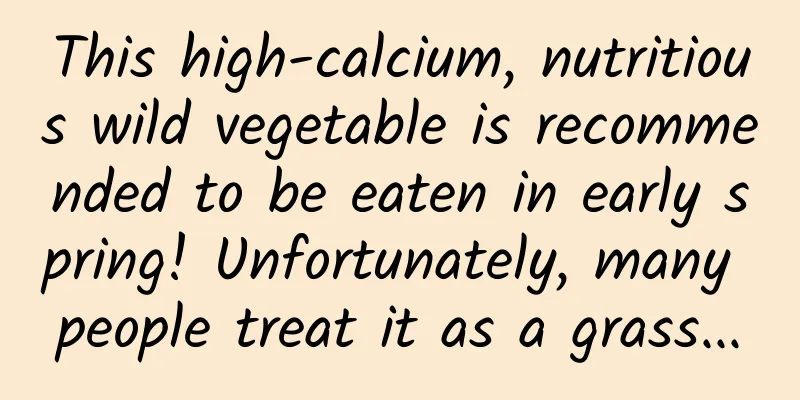This high-calcium, nutritious wild vegetable is recommended to be eaten in early spring! Unfortunately, many people treat it as a grass...

|
In spring, everything comes back to life, and all kinds of wild vegetables are sprouting. Shepherd's purse, Chinese toon, Sophora japonica, Purslane, these wild vegetables are no strangers to everyone, but have you heard of noodle vegetable? This "nail house in the wheat field" that once gave farmers a headache turned out to be a top-notch wild vegetable in spring. At this time of year, many people go to the fields to dig for weeds, but it should be emphasized that this is not recommended! If you mistakenly pick weeds that look similar but are poisonous, you may be poisoned if you eat them by mistake . Fortunately, noodles have been commercialized and grown in large quantities, so everyone can still safely taste the "delicious gift" of spring . Today, let's talk about the nutrition and fancy cooking methods of noodles. Copyright images in the gallery. Reprinting and using them may lead to copyright disputes. Stubborn weeds in the wheat field The noodle vegetable got this down-to-earth name in Henan and other places because its young leaves are smooth and resemble noodles when cooked. Noodles are also called rice pots, and their scientific name is bottle grass. They belong to the genus Flywort of the Caryophyllaceae family. They have been "fishing in troubled waters" since wheat was sown - their seeds germinate in the wheat seeds, and their seedlings grow close to the ground in a gray-green rosette shape, with their own white fluff camouflage, making it almost "indistinguishable" from wheat seedlings . When wheat joints in spring, it also jumps to 30 cm in height, and spreads its fine sand-like seeds into the soil before harvesting, causing a lot of trouble for farmland management. Therefore, it is also a stubborn weed hidden in the wheat field. This wild grass, which originated in the Yellow River Basin, is now widely distributed in major grain-producing areas across the country. From the wheat fields of Henan to the wasteland and grass slopes of Jiangsu and Shandong, from the dry land in the northwest to the black soil in the northeast, wherever crops are grown, you can always see it snatching nutrients and occupying land. Why are noodles so tenacious? It all depends on three survival skills: ● The lantern-like structure of the flower can store morning dew as a source of water. ● The seeds have mucus on their surface, which can stick to farm machinery and animals and spread. ● Seeds underground can remain dormant for many years and only germinate when they encounter the right environment. Thanks to these abilities, it has managed to survive in farmlands for thousands of years, becoming one of the most difficult weeds to remove. Image source: China Higher Plant Database However, this wild grass that causes headaches for farmers actually contains unexpected nutritional value. What’s special about nutrition? Like green leafy vegetables, pasta is low in calories and high in fiber. In addition to this advantage, pasta is a treasure trove of nutrients. 1 Vitamin C According to the data of the Chinese Food Composition Table (Standard Edition), every 100 grams of fresh noodles contains 49 mg of vitamin C, which is nearly 50% higher than oranges (33 mg/100 grams). In simple terms, if you don’t consider the loss during cooking, eating a handful of noodles (about 200 grams) can meet the vitamin C needs of an adult for the whole day. High temperature and short cooking time can reduce the loss of vitamin C. It is good to mix it with cold food after blanching. It is even better to add a few drops of vinegar when mixing it with cold food, because the acidic environment is conducive to the preservation of vitamin C. 2 Minerals The calcium content of noodles is 153 mg/100 g, which is 1.5 times that of pure milk (107 mg/100 g). However, because it is a plant-based source, the absorption rate is lower than that of milk. It is recommended to pair it with ingredients that are relatively high in vitamin D (such as mushrooms and egg yolks) to make the calcium supplementation effect more effective. In addition to calcium, the iron content of celery is also high among plants. It contains 4.5 mg of iron per 100 g. Compared with spinach (2.9 mg iron/100 g), the iron content of celery is 1.6 times that of spinach, making it one of the few vegetables that are good at supplementing iron. Combined with its own vitamin C, it can increase the absorption rate of non-heme iron in plants. 3 Antioxidant ingredients The carotene content of noodles is 4160 micrograms/100 grams, which is equivalent to the content of 500 grams of mango, slightly better than carrots (4107 micrograms). Carotene not only has an antioxidant effect, but can also be converted into vitamin A in the body. Adding vegetable oil to mix with blanching can increase the absorption rate of carotene. In addition to carotene, antioxidant flavonoids are also very rich. Wang Shuangxi and other scholars found that glutathione extracted from noodles has good in vitro antioxidant activity; Liu Meiyan and others' experiments also verified that among the common wild vegetables in northern Jiangsu, the SOD activity of noodles (miwa jar) is much higher than that of the other four wild vegetables. Image source: Reference [6] How to eat more safely? If you want to eat it, it is recommended to buy it from reliable channels, such as farmers' markets, supermarkets or online shopping platforms. These channels usually conduct regular inspections to ensure the safety of the ingredients. Some online shopping platforms also provide quality inspection reports to make consumers feel more assured when eating. When purchasing, be sure to choose noodles with bright green leaves, no yellow spots, and no insect bites , to avoid buying contaminated or spoiled products. Image source: An online grocery shopping platform If you insist on picking them yourself, you need to pay special attention to two points: ● First, the site should be far away from pollution sources. Wild vegetables close to roads are easily polluted by automobile exhaust, which can easily lead to excessive lead and cadmium levels; ● The second is to identify the plants accurately. If you don’t often pick wild vegetables, it is very easy to get confused. It is recommended that you don’t pick them to avoid picking plants that look similar but are poisonous. The surface of the greens just picked from the wild may be clinging to some dirt, impurities, and pesticide residues. Before eating, be sure to clean the greens. You can rinse them with running water for 30 seconds with the leaves facing down to remove surface mud and reduce residual impurities. How to make it delicious? 1 Steamed noodles: the most classic way to eat The texture is soft and sticky, fragrant and delicious, enough to finish two bowls of rice! 1. Remove the old roots of fresh noodles, rinse with clean water, shake off the water droplets and set aside. 2. Spray oil on the surface of the dish and sprinkle appropriate amount of flour (cornmeal and) on it, making sure each leaf is evenly coated with flour. 3. Put the noodles coated with flour into the steamer, and steam over high heat for about 3 minutes after the water boils. 4. Prepare garlic sauce: minced garlic + light soy sauce + sesame oil + chili oil, pour into the steamed vegetables and mix well. Copyright images in the gallery. Reprinting and using them may lead to copyright disputes. 2 Cold three-shredded vegetables: refreshing and appetizing 1. Wash the noodles and blanch them in boiling water for about 1 minute. Remove from the water, let them cool, and then cut them into sections. 2. Grate the carrots, cut the soaked vermicelli into short pieces, blanch them in boiling water until softened and remove from the water. 3. Mix the three shreds and place on a plate. Sprinkle with toasted sesame seeds. 4. Soul sauce: 2 spoons of balsamic vinegar + 1 spoon of light soy sauce + half a spoon of sugar + appropriate amount of sesame oil, mix well and pour on. 3 Wild vegetable pancakes: a new favorite for breakfast 1. Chop the noodles, beat two eggs, and add flour to make a yogurt-like batter. 2. Brush a thin layer of oil on the pan, scoop a spoonful of batter and spread it in circles. 3. Fry over low heat until the edges curl up, then turn over and fry until the crust is golden brown and crispy. 4. Roll it up with braised beef slices and cucumber strips, it’s even more delicious than a pancake. In addition to the three ways listed above, noodles can also be fried and eaten. They are a perfect match with eggs, tofu, and bacon. They are delicious with any combination. They are also good for making soup or dumpling fillings. You can try it. Do you have any special ways to eat noodles? Please leave a message to share your " spring secrets "! Take advantage of the spring and go to the vegetable market to grab this green and add some wildness to the table. However, it should be reminded that excessive consumption of noodles may cause gastrointestinal discomfort. Generally speaking, the best amount for each consumption is no more than 150 grams. References [1] China Higher Plant Database. Kmzw. https://web.archive.org/web/20160305021633/http://www.bioinfo.cn/db05/KmzwSpecies.php?action=view&id=1856 [2] Chinese Nutrition Society. Encyclopedia of Chinese Nutrition Science, 2nd Edition (Volume 1). People's Medical Publishing House, 2019 [3] Liu Hongjun, Jin Songtao. A review of research on wild vegetables - Noodles[J]. Modern Horticulture, 2023, 46(12 ):15-18.DOI:10.14051/j.cnki.xdyy.2023.12.045. [4] Zhang Jian, Liu Meiyan. Analysis of nutritional components of rice pot [J]. Journal of Nutrition, 2005, (01): 75-76. [5] Liu Meiyan, Zhang Jian. Analysis of antioxidant components of five wild vegetables[J]. Journal of Plant Resources and Environment, 2004, (01): 58-59. [6] Wang Shuangxi, Li Shuxian, Gan Haijin, et al. Study on the antioxidant activity of glutathione from Ophiopogon japonicus in vitro[J]. Journal of Practical Chinese Internal Medicine, 2020, 34(9): 18-21. DOI: 10.13729/j.issn.1671-7813.Z20200237. [7] iPlant Plant Intelligence. Silene conoidea. https://www.iplant.cn/info/Silene%20conoidea?t=z&id=842AB158BB71911F [8] Yang Yuexin. Chinese Food Composition Table 6th Edition Volume 1[M]. Peking University Medical Press, 2018 Planning and production Author: Li Chun, registered nutritionist Review丨Wang Kang, Director of the Science Museum of the National Botanical Garden Ruan Guangfeng, Deputy Director of Kexin Food and Health Information Exchange Center Planning丨Zhong Yanping Editor: Zhong Yanping Proofread by Xu Lailinlin The cover image and the images in this article are from the copyright library Reprinting may lead to copyright disputes |
<<: Heat destroys everything, but physicists find an exception
Recommend
How can domestic mobile phones survive without the aphrodisiac of operators?
On September 17, the news that Coolpad laid off 1...
Urgent reminder! Don’t eat this kind of fruit on the roadside!
Summer is here It's fruit season again Especi...
Don't turn the pages! Tell me right now, which plants can be used for dyeing?
"Remembering the green skirt, I pity the fra...
T-Online: Survey shows that more than 94% of Germans explicitly refuse to buy Tesla
Recently, a new survey of 100,000 Germans conduct...
Why do we love drinking boiled water?
When it comes to drinking boiled water, I believe...
iQiyi advertising account opening, iQiyi promotion billing
The average online time of iQiyi users is long an...
Realme Q3 review: unrivaled performance in its class, a model of the best smartphones under 1,000 yuan
What is the most difficult thing for a painter to...
The most useful "bucket waist" in the world can hold 2 tons of water!
In the magical nature, there are many kinds of cr...
Easily find the storage location of WeChat received files
I believe many people have encountered this situa...
Wanliniu e-commerce product analysis!
E-commerce ERP is a pioneer of domestic SAAS ERP ...
Let's talk about APP push and analyze how each end collaborates to complete the push task
[51CTO.com original article] Push function has be...
Brand marketing promotion, how to make H5?
How to make H5? Based on my thoughts and ideas fr...
6 Mindsets to Learn JavaScript Faster
[[151268]] When we learn JavaScript, or any other...
Internet marketing? The one who praises you and scolds you is your good man
Can you do good Internet marketing at 0 cost? cer...
The hottest temperature of the year is coming! Check out this summer cooling strategy while it's hot →
China Weather Net predicts that from June 14 to t...









